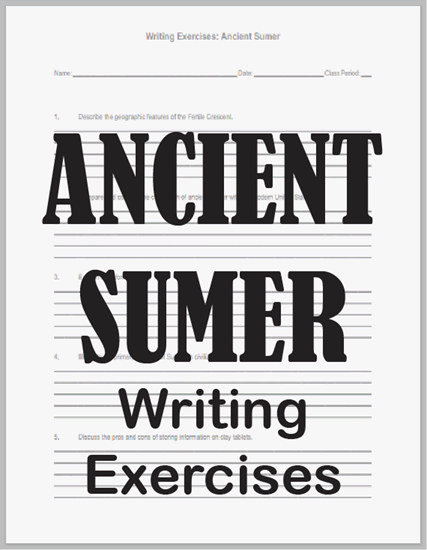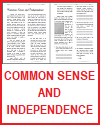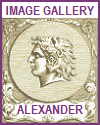| Ancient Sumer Writing Exercises |
|---|
| www.studenthandouts.com > World History > Ancient Near East > Ancient Near East Worksheets |
 |
 |
|---|
|
1. Describe the geographic features of the Fertile Crescent. 2. Compare and contrast the civilization of ancient Sumer with the modern United States. 3. Explain cuneiform writing. 4. Illustrate the primary features of Sumerian civilization. 5. Discuss the pros and cons of storing information on clay tablets. Click here to print (PDF file). Answers will vary. |
|---|
|
Storing information on clay tablets, a practice that dates back to ancient civilizations like Mesopotamia, has both advantages and disadvantages. Here are the pros and cons of using clay tablets for information storage.
Pros: Durability: Clay tablets are highly durable and can withstand a wide range of environmental conditions, including moisture, heat, and physical damage. This makes them suitable for long-term preservation. In fact, many of the ancient tablets we are able to read today, were preserved precisely because they were burned. Longevity: Clay tablets have a long lifespan, often lasting for thousands of years. This has allowed historians and archaeologists to recover valuable historical records from ancient civilizations. Inscription Depth: The process of inscribing information onto clay tablets by pressing or carving ensures that the text remains legible even after many centuries. Hard Copy: Clay tablets are physical records, which means they are not susceptible to digital data loss, hardware failures, or software obsolescence. They provide a hard copy of information. Cultural Heritage: Clay tablets are important cultural artifacts that provide insights into the languages, writing systems, and cultures of ancient civilizations. They are invaluable for understanding the past. Reliability: Clay tablets are less prone to data corruption or alteration compared to digital storage methods. They provide a level of reliability for preserving information. Non-reliance on Electricity: Clay tablets do not rely on electricity or technology for storage, which means they can be accessed even in areas without modern infrastructure. Cons: Bulk and Weight: Clay tablets are heavy and bulky, making them impractical for storing large volumes of information. This limits their use for extensive archives. Fragility: While clay tablets are durable, they can still break or shatter if subjected to physical stress or impact. This poses a risk to the preservation of the information. Limited Storage Capacity: Clay tablets have limited space for text. Writing on them is time-consuming and labor-intensive, which means they can only contain a limited amount of information compared to modern storage methods. Accessibility: Accessing information on clay tablets requires physical handling, which can be challenging for fragile or damaged tablets. Reading inscriptions may also require specialized expertise in deciphering ancient scripts, such as cuneiform. Reusability: In some ancient cultures, clay tablets were sometimes recycled by erasing the existing inscriptions and reusing the clay. This resulted in the loss of valuable historical records. Language and Script Barriers: Understanding and interpreting the information on clay tablets can be challenging, especially if the language and writing system are no longer in use. Deciphering ancient scripts can be a specialized skill. Scribes were trained and employed for just this purpose in the ancient Fertile Crescent. Limited Portability: Due to their weight and fragility, transporting clay tablets over long distances is cumbersome and risky, which limits their practical use for disseminating information beyond a local area. Vulnerability to Natural Disasters: While clay tablets are resistant to some environmental factors, they are not immune to natural disasters such as earthquakes or floods, which can lead to the destruction of information. Clay tablets have played a crucial role in preserving historical records and cultural heritage, offering durability and longevity. However, they have limitations in terms of storage capacity, accessibility, and portability, making them less practical for modern information storage needs. Today's paper, let alone digital storage methods, have largely supplanted clay tablets for efficiency, accessibility, and convenience. |
| www.studenthandouts.com > World History > Ancient Near East > Ancient Near East Worksheets |









